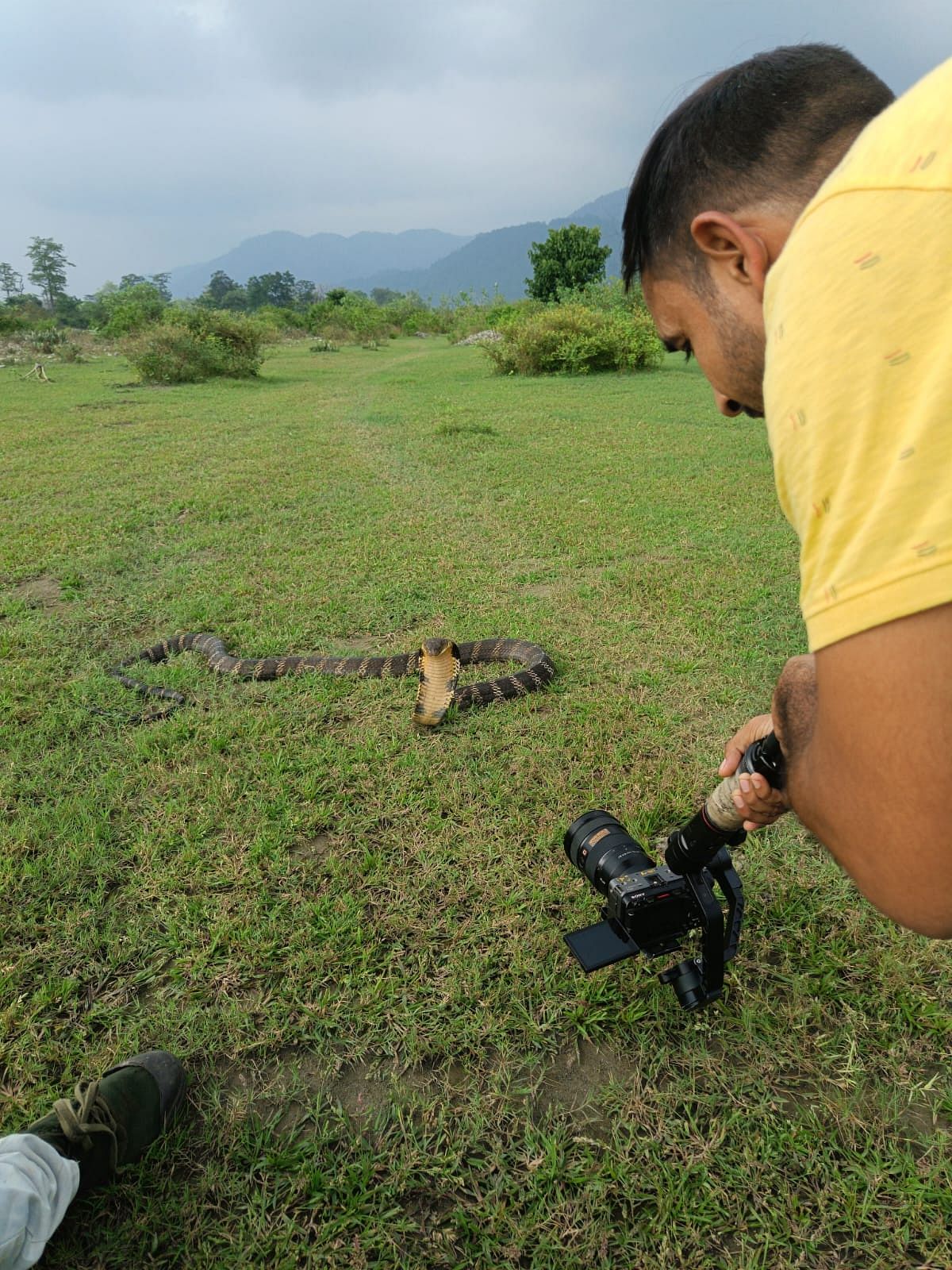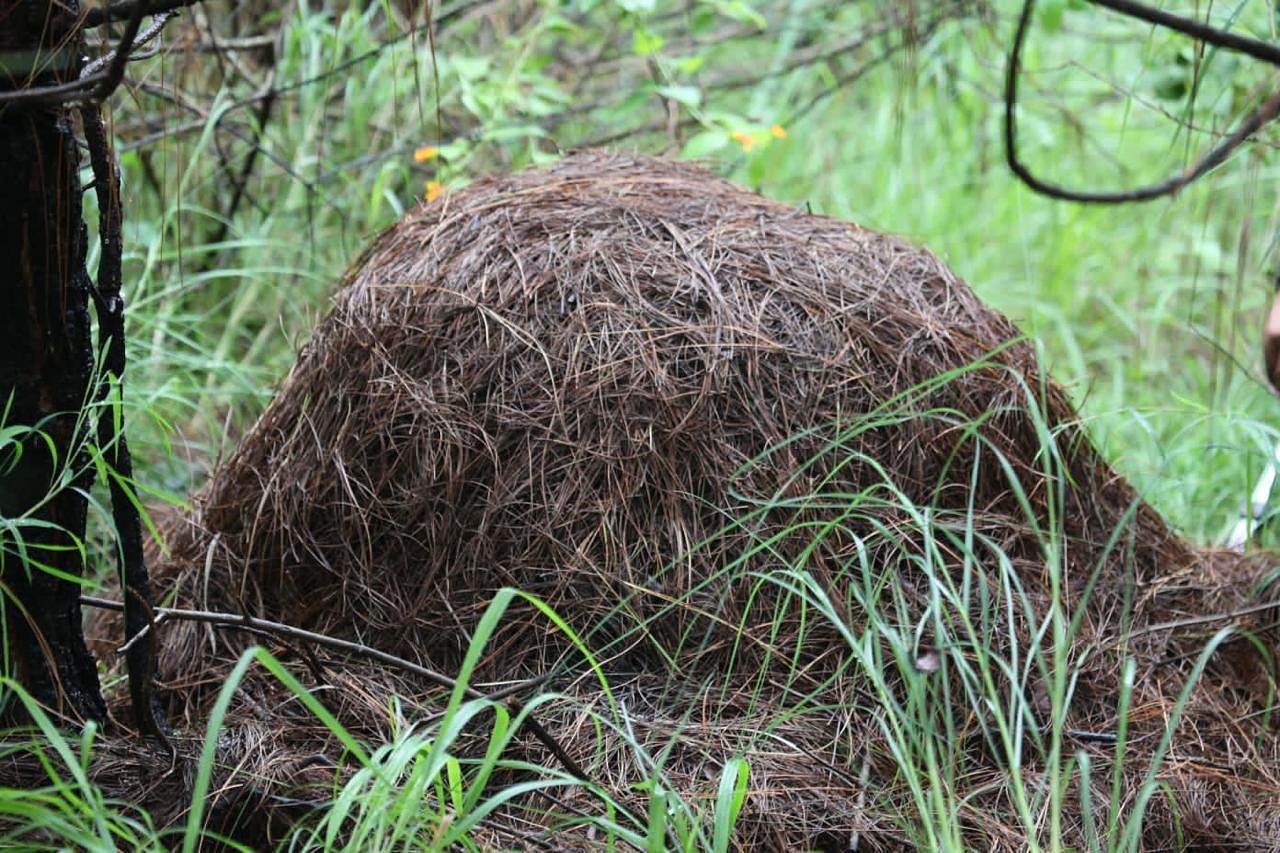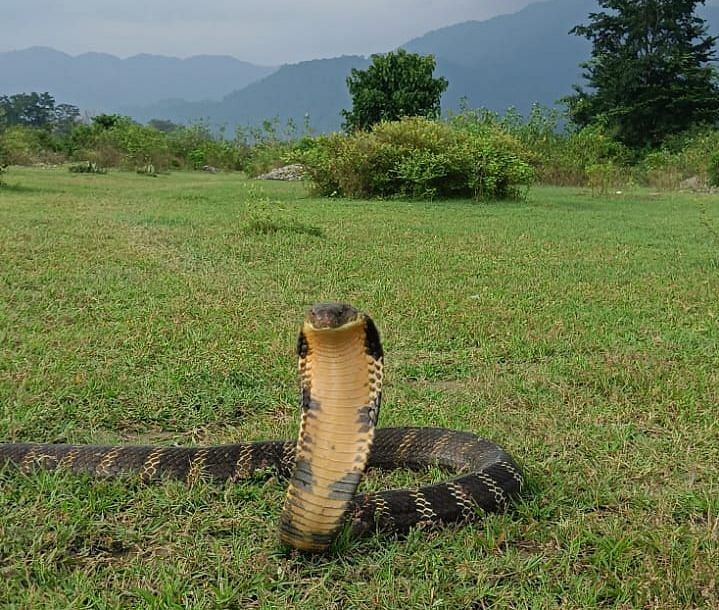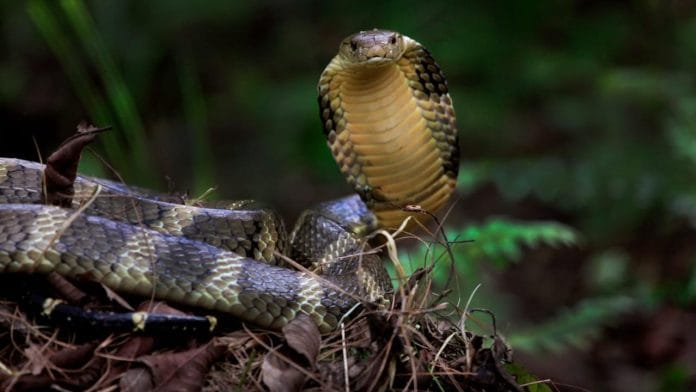What mattered now was the survival of her two dozen yet-to-be-born offspring. For many days, she had been furiously collecting fallen leaves and twigs in a lonely patch of sal forest in Uttarakhand, trying to build a nest. Time was running out; she had to lay her eggs soon.
From a safe distance, our camera team closed in on the 14-foot-long King Cobra, watching in rapt attention as the world’s longest venomous snake—a creature known to carry a fearsome reputation of having enough venom to kill an elephant with a single bite—worked with the precision of an artist. Then, one morning, she uttered a loud moan of satisfaction. Anyone with acute hearing could detect that telltale sound from 50 feet away. She had just finished building her nest, a structure three feet high and with an impressive girth of over two metres.
It all began in August 2023 when the forest department of Uttarakhand commissioned us for an enviable project: to make a film on the King Cobra found in the Himalayan state. The assignment was both exciting and daunting. Nobody had ever made a film on the Himalayan King Cobra before. The only detailed film on the Indian King Cobra was produced in South India about two decades ago by the legendary “snake man,” Romulus Whitaker.
Fast forward to Tuesday, 8 October 2024, when the governor of Uttarakhand, Lt. General (retired) Gurmit Singh, unveiled our film at Raj Bhavan. Also present were the state forest minister Subodh Uniyal and top officials from the Uttarakhand forest department. And pray, what was the governor’s first reaction upon seeing the film? “A King Cobra is actually a saint. A true friend of the people. I have just realised this!’’ he exclaimed.

But getting close to this “saint” was not easy. Our first cameraman ran away minutes after doing a Google search on the King Cobra. Eventually, we enlisted two cinematographers, and filming continued for the next 11 months, mostly in the deep forest tracks, leech-infested ravines, and meandering riverbeds of Uttarakhand. The realisation that the King Cobra is the longest venomous snake in the world, with no available antidote in India, never really left us throughout the filming, which stretched into various locations across the Kumaon and Garhwal divisions.
True, a King Cobra could put an elephant to sleep if it chose to, but it rarely strikes at animals that are not its natural prey. Happily swaying through life along the lonely furrow of time-tunnel, with no friends or companions, the King Cobra does not get easily provoked. But when it does, there is little one can do to escape its wrath.
Learning about King Cobra
As our filming progressed, we became acquainted with several fascinating aspects of this mighty snake. For instance, the King Cobra is the only snake that builds a nest. Within the nest, it sets up a sanctum sanctorum where it keeps 20 to 50 eggs at an optimal temperature of 26 to 28 degrees Celsius.
There is, however, a remarkable twist in the King Cobra’s tale. A behavioural trait not seen in any other species is that the mother cobra abandons the nest a few days before the eggs hatch. At first glance, this may seem strange or even cruel, but it can be viewed as a manifestation of pure maternal love. The King Cobra’s primary diet consists of other snakes, so by leaving the eggs and throwing the newborn babies to the tender mercies of fate, the mother ensures she does not end up eating them.

Now, it may sound staid if you are told that the King Cobra has not killed any humans in Uttarakhand. In contrast, most people who fall foul of wild animals in India are often killed by Lord Ganesha’s avatar elephant and Mowgli’s good friend Baghera (the leopard)—these two carry far less fearsome reputations than the King Cobra.
The King Cobra is a different breed altogether. Much like the famed Greek philosopher Diogenes, who asked Alexander the Great to stay out of his light, the King Cobra exhibits a similar mindset.
“It’s a thinking snake that assesses the situation before making a threatening move,” said Jignasu Dolia, a well-known snake expert. Dolia has been doing a PhD on the nesting behaviour of King Cobras in Uttarakhand and is associated with the Wildlife Institute of India (WII) in Dehradun.
Dolia and his associate Krishna were instrumental in the making of the film, becoming integral to our crew and guiding us to various King Cobra nesting sites.
But why does a King Cobra build a nest in the first place? This time-consuming process depletes so much of its energy. Why doesn’t it behave like a Burmese or an Indian python, which creates optimal temperatures by coiling around its eggs and raising heat through shivering thermogenesis?
“We don’t really know why a King Cobra builds a nest. Nobody has an answer to this,” Dolia admitted.
What we do know is that the King Cobra plays a vital role in maintaining ecological balance. Other, smaller snakes constitute its primary diet, and by eating them, it helps keep their population in check. Much like a tiger does by ensuring that deer and other herbivores, its main prey, do not overpopulate and pose a threat to the forest.

Watching a King Cobra in the wild produces a mix of extreme emotions—excitement, awe, and fear being the top three. Waiting for a tiger to appear in the Khinnanauli grassland of Corbett Tiger Reserve one afternoon many years ago, I saw a herd of over 30 elephants suddenly running in different directions, scampering for cover. No, the tiger had not arrived; instead, a King Cobra hiding in the grass about 200 yards away had merely raised its hood..
Active participants in the making of our 35-minute film included noted photographer, mountaineer, and Padma Shri awardee Anup Sah, wildlife enthusiast Parth Sharma (both in the role of producers), and Ajay Suri, who wrote the script and directed the film.
(Edited by Prashant)






